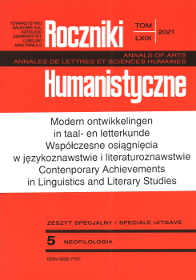Van conferentie naar de publieke sector... Pleidooi voor het verleggen van de focus van de tolktraining in combinaties van kleinere talen
Abstrakt
Od konferencji do sektora publicznego... Apel o przeniesienie uwagi w szkoleniach tłumaczy języków niszowych z tłumaczenia konferencyjnego na tłumaczenia ustne w sektorze publicznym (PSIT)
Od czasu pierwszej konferencji Critical Link w 1995 r. datuje się wzrost zainteresowania tłumaczeniami ustnymi w zakresie tłumaczeń ustnych i pisemnych w sektorze publicznym (Public Service Interpreting and Translation, PSIT), określanymi w Belgii jako tłumaczenia społeczne. Przeniesienie uwagi z tłumaczeń konferencyjnych na PSIT było odpowiedzią na potrzebę integracji migrantów i ich udziału w społeczeństwie. Niniejszy artykuł jest apelem o wdrożenie tłumaczeń ustnych w sektorze publicznym (PSIT) do kształcenia tłumaczy studentów rzadziej używanych języków, w tym studentów filologii niderlandzkiej. Po zdefiniowaniu podstawowych pojęć i opisie sytuacji PSIT w Europie Środkowej zaproponowano projekt PACI, który jest inspiracją do rewizji lub uzupełnienia klasycznych programów nauczania filologii niderlandzkich extra muros (NEM) o dodatkową ścieżkę szkoleniową dla tłumaczeń ustnych w sektorze publicznym (PSIT).
Bibliografia
Bossaert, Benjamin. “Institucionalizace a profesionalizace komunitního tlumočení ve Vlámsku.” Komunitní tlumočení v České republice a v nizozemsky hovořících zemích, onder redactie van Pavlína Knap-Dlouhá e. a. Univerzita Palackého v Olomouci, 2020, pp. 130-132.
Chesher, Tery. Rhetoric and reality. Two decades of community interpreting and translating in Australia, 1997. Beschikbaar op https://doi.org/10.1075/btl.19.29che. Geraadpleegd op 20.03.2021.
Crossing Borders in Community Interpreting: Definitions and dilemmas, onder redactie van C. Valero-Garcés en A. Martin. John Benjamin’s.
Djovčos, Martin, en Pavol Šveda, editors. Didaktika prekladu a tlmočenia na Slovensku. Bratislava: Veda, 2018.
Djovčoš, Martin, en Pavol Šveda. Mýty a fakty o preklade a tlmočení na Slovensku. Bratislava: Veda, 2017.
Hale, Sandra Beatriz. Community Interpreting. Palgrave Macmillan, 2007.
Hertog, Erik, en Bart van der Veen. “Taking Stock: Research and Methodology in Community Interpreting”. Linguistica Antverpiensia. New Series, nr. 5, 2006, pp. 11-17.
Jacobsen, Benthe. “The community interpreter: a question of role.” Hermes – Journal of language and communication studies, nr. 42, 2009, pp. 155-166.
Pöchhacker, Franz. “Research and Methodology in Healthcare Interpreting.” Linguistica Antverpiensia: New Series, nr. 5, 2006, pp. 135–159.
Rudvin, Mette. “The Cultural Turn in Community Interpreting: A Brief Analysis of Epistemological Developments in Community Interpreting Literature in the Light of Paradigm Changes in the Humanities.” Linguistica Antverpiensia: New Series, nr. 5, pp. 21-41.
Štefková, Marketa, Koen Kerremans en Benjamin Bossaert. Learning from good examples. Professionalisation of community interpreting in Central Europe. Univerzitné vydavateľstvo UK, 2020 (online beschikbaar: www.kgns.info/intellectual-outputs. Geraadpleegd op 20.05.2021)
Tužinská, Helena. “Communication In The Asylum Courts. Limits od Inquiry.” Slovenský Národopis, vol. 57, nr. 5, 2009, pp. 560-578.
Tužinská, Helena. Questions of Description and Translation: Using Data from Anthropology and Ethnology in the Conduct and Interpretation of Interviews with Immigrants. Stimul, 2010 (online beschikbaar: www.old.hrl.sk/publikacie. Geraadpleegd op 20. 03.2021).
Tužinská, Helena. Medzi riadkami. Bratislava: ArtForum, 2019.
Vargas Urpi, M. “State of the art in community interpreting research: mapping the main research topics.” Babel, vol. 58, nr. 1, 2012, pp. 50-72.
Copyright (c) 2021 Roczniki Humanistyczne

Utwór dostępny jest na licencji Creative Commons Uznanie autorstwa – Użycie niekomercyjne – Bez utworów zależnych 4.0 Międzynarodowe.





